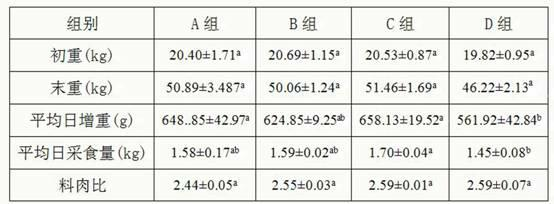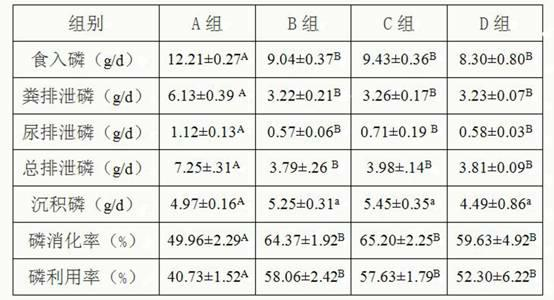Compound feed for reducing nitrogen and phosphorus excretions of growing pigs
A technology of compound feed and excretion, which is applied in the field of pig feed, can solve problems such as water quality deterioration, environmental pollution, and accelerated overgrowth of aquatic plants and algae, and achieve the effect of reducing excretion and improving utilization
- Summary
- Abstract
- Description
- Claims
- Application Information
AI Technical Summary
Problems solved by technology
Method used
Image
Examples
Embodiment 1
[0011] The compound feed for reducing the nitrogen and phosphorus excretion of growing pigs provided in this example is made by mixing the following components in mass percentage: 67.36% corn, 2.35% rice bran, 6% bran, 19% soybean meal, stone powder 1.5%, calcium hydrogen phosphate 0.3%, salt 0.3%, lysine 0.45%, methionine 0.15%, threonine 0.14%, soybean oil 1.5%, pig multidimensional 0.05%, phytase 0.1%, compound enzyme preparation 0.1% , Premix 0.7%.
Embodiment 2
[0013] The compound feed for reducing the nitrogen and phosphorus excretion of growing pigs provided in this example is made by mixing the following components in mass percentage: 66.55% corn, 3.6% rice bran, 5% bran, 19% soybean meal, stone powder 1.5%, calcium hydrogen phosphate 0.4%, salt 0.3%, lysine 0.44%, methionine 0.14%, threonine 0.12%, soybean oil 2%, pig multidimensional 0.05%, phytase 0.1%, compound enzyme preparation 0.1% , Premix 0.7%.
Embodiment 3
[0015] The compound feed for reducing the nitrogen and phosphorus excretion of growing pigs provided in this example is made by mixing the following components in mass percentage: 62.97% of corn, 5% of rice bran, 5.3% of bran, 20% of soybean meal, stone powder 1.4%, calcium hydrogen phosphate 0.5%, salt 0.3%, lysine 0.43%, methionine 0.1%, threonine 0.1%, soybean oil 3%, pig multidimensional 0.05%, phytase 0.1%, compound enzyme preparation 0.05% , Premix 0.7%.
[0016] The premixes in Embodiment 1-Example 3 are all prepared by themselves, containing 2.00g of copper, 10.00g of zinc, 10.00g of iron, 0.400g of manganese, 27.64mg of iodine, 30.18mg of selenium, sulfuric acid viscose in every kilogram of premix. 50 g of mycocin, 50 g of salinomycin aqueous solution with a mass percent concentration of 10%, and the bran of the remainder.
PUM
 Login to View More
Login to View More Abstract
Description
Claims
Application Information
 Login to View More
Login to View More - R&D
- Intellectual Property
- Life Sciences
- Materials
- Tech Scout
- Unparalleled Data Quality
- Higher Quality Content
- 60% Fewer Hallucinations
Browse by: Latest US Patents, China's latest patents, Technical Efficacy Thesaurus, Application Domain, Technology Topic, Popular Technical Reports.
© 2025 PatSnap. All rights reserved.Legal|Privacy policy|Modern Slavery Act Transparency Statement|Sitemap|About US| Contact US: help@patsnap.com



